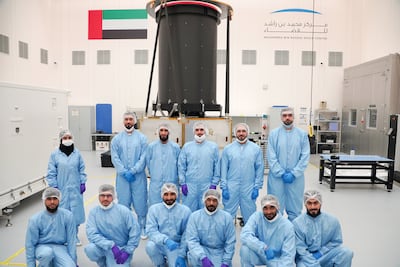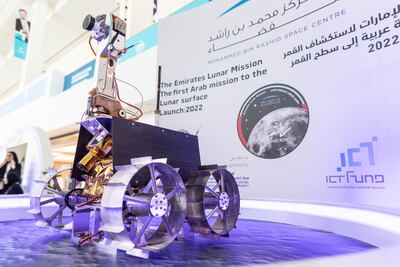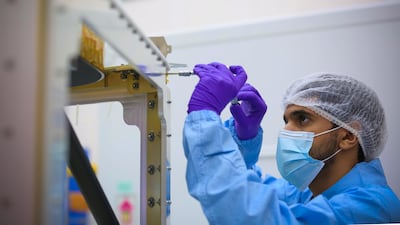UAE space mission officials are in talks with SpaceX about a launch date for an Earth observation satellite built by Emirati engineers, after the company's Falcon 9 rocket was grounded by US authorities because of technical problems.
The MBZ-Sat satellite was scheduled for launch this month, but that is now uncertain as the Federal Aviation Administration (FAA) completes an investigation into the issues. The SpaceX rocket has suffered several problems this year.
Amer Al Sayegh, senior director of the space engineering department at the Mohammed bin Rashid Space Centre, told The National on Tuesday that discussions were being held with SpaceX to finalise a launch date. The satellite will remain in the UAE before it is shipped to a spaceport in Florida for launch.
“They have had these recent incidents with their launcher, so we are in discussion with them to finalise the date,” Mr Al Sayegh said on the sidelines of the Space Research Conference, held by the UAE Space Agency in Abu Dhabi. “They’ve had a few other [incidents] before, in July and in August, some failures in second stage, so the FAA has worked with them on improvement, and so we're still waiting for confirmation from them.”
The MBZ-Sat, named after President Sheikh Mohamed, is a key part of the UAE's efforts to establish a strong private space sector through collaborations between government-run space centres and private companies. With 90 per cent of the satellite built by UAE companies, the project is aimed at bolstering those efforts and so encouraging further investment and development in the sector.
The space centre worked with five private companies in the country to develop the satellite – aerospace manufacturing company Strata, engineering solutions company EPI, management consultancy Rockford Xellerix, Halcon, a company that manufactures precision-guided systems, and Falcon Group, an inventory management company.
MBZ-Sat is three times more powerful than KhalifaSat, an Emirati-built satellite operating Earth since 2018.
MBZ-Sat has a fully automated image scheduling and processing system that will allow it to produce 10 times more images than the space centre does.
Its downlink data transmission speed will be three times faster than its predecessor.
“All of these companies have been with us since the beginning,” Mr Al Sayegh said. “We're proud that their products are now part of the satellite that will go to space.”
Incidents with SpaceX rocket
The Falcon 9 has suffered three technical problems in three months, leading the FAA to ground the rocket. The latest incident was on September 28, when the booster missed its re-entry zone in the South Pacific.
The FAA launched an investigation into the incident and has since only allowed one SpaceX mission to launch, while others are grounded. In the summer, the agency grounded the rocket for two weeks after an incident on July 11 that involved a liquid-oxygen leak in the upper stage. This resulted in the loss of 20 Starlink satellites.
On August 28, the rocket being grounded for two days after a failed landing attempt.
Grounding a rocket causes disruption, with aerospace companies forced to delay missions until the FAA finishes its investigation and clears the rocket for launch. This creates a backlog of payloads waiting to go to space, forcing the company to adjust timetables and perhaps miss launch windows for time-sensitive missions.
Despite these setbacks, SpaceX is regarded as one of the most dependable companies in the space industry.
Rashid rover 2
Mr Al Sayegh also discussed the second Rashid lunar rover project. The four-wheeled rover is being developed after the landing vehicle carrying its predecessor crashed-landed on the surface of the Moon last year.
The space centre selected Hakuto-R Mission 1, a lander built by Japanese company ispace, to carry the first rover to the Moon.
The space centre has finalised a deal for a lander to carry the new rover and an announcement should be made “soon”, Mr Al Sayegh said.
“We've already started working on the second rover and we're good in terms of schedule,” he said. “In the current decision, we've taken into consideration which company has done it before and has already got experience. Our target is to reach the surface of the Moon and we'll do it, from our perspective, the most successful, safest way.”
There have been several lunar landing attempts by private companies in the past three years, including US companies Astrobotic and Intuitive Machines. Astrobotic's mission with its Peregrine lander ended in failure, with the spacecraft incapable of making a controlled descent to the lunar surface.
The Nova-C lander by Intuitive Machines was hailed as a success despite breaking a landing leg on touchdown, marking the first American lunar landing since the Apollo era. The spacecraft transmitted data for about a week after landing.
Our family matters legal consultant
Name: Hassan Mohsen Elhais
Position: legal consultant with Al Rowaad Advocates and Legal Consultants.
Monster Hunter: World
Capcom
PlayStation 4, Xbox One
Mercer, the investment consulting arm of US services company Marsh & McLennan, expects its wealth division to at least double its assets under management (AUM) in the Middle East as wealth in the region continues to grow despite economic headwinds, a company official said.
Mercer Wealth, which globally has $160 billion in AUM, plans to boost its AUM in the region to $2-$3bn in the next 2-3 years from the present $1bn, said Yasir AbuShaban, a Dubai-based principal with Mercer Wealth.
“Within the next two to three years, we are looking at reaching $2 to $3 billion as a conservative estimate and we do see an opportunity to do so,” said Mr AbuShaban.
Mercer does not directly make investments, but allocates clients’ money they have discretion to, to professional asset managers. They also provide advice to clients.
“We have buying power. We can negotiate on their (client’s) behalf with asset managers to provide them lower fees than they otherwise would have to get on their own,” he added.
Mercer Wealth’s clients include sovereign wealth funds, family offices, and insurance companies among others.
From its office in Dubai, Mercer also looks after Africa, India and Turkey, where they also see opportunity for growth.
Wealth creation in Middle East and Africa (MEA) grew 8.5 per cent to $8.1 trillion last year from $7.5tn in 2015, higher than last year’s global average of 6 per cent and the second-highest growth in a region after Asia-Pacific which grew 9.9 per cent, according to consultancy Boston Consulting Group (BCG). In the region, where wealth grew just 1.9 per cent in 2015 compared with 2014, a pickup in oil prices has helped in wealth generation.
BCG is forecasting MEA wealth will rise to $12tn by 2021, growing at an annual average of 8 per cent.
Drivers of wealth generation in the region will be split evenly between new wealth creation and growth of performance of existing assets, according to BCG.
Another general trend in the region is clients’ looking for a comprehensive approach to investing, according to Mr AbuShaban.
“Institutional investors or some of the families are seeing a slowdown in the available capital they have to invest and in that sense they are looking at optimizing the way they manage their portfolios and making sure they are not investing haphazardly and different parts of their investment are working together,” said Mr AbuShaban.
Some clients also have a higher appetite for risk, given the low interest-rate environment that does not provide enough yield for some institutional investors. These clients are keen to invest in illiquid assets, such as private equity and infrastructure.
“What we have seen is a desire for higher returns in what has been a low-return environment specifically in various fixed income or bonds,” he said.
“In this environment, we have seen a de facto increase in the risk that clients are taking in things like illiquid investments, private equity investments, infrastructure and private debt, those kind of investments were higher illiquidity results in incrementally higher returns.”
The Abu Dhabi Investment Authority, one of the largest sovereign wealth funds, said in its 2016 report that has gradually increased its exposure in direct private equity and private credit transactions, mainly in Asian markets and especially in China and India. The authority’s private equity department focused on structured equities owing to “their defensive characteristics.”
The Settlers
Director: Louis Theroux
Starring: Daniella Weiss, Ari Abramowitz
Rating: 5/5
If you go
The flights
There are direct flights from Dubai to Sofia with FlyDubai (www.flydubai.com) and Wizz Air (www.wizzair.com), from Dh1,164 and Dh822 return including taxes, respectively.
The trip
Plovdiv is 150km from Sofia, with an hourly bus service taking around 2 hours and costing $16 (Dh58). The Rhodopes can be reached from Sofia in between 2-4hours.
The trip was organised by Bulguides (www.bulguides.com), which organises guided trips throughout Bulgaria. Guiding, accommodation, food and transfers from Plovdiv to the mountains and back costs around 170 USD for a four-day, three-night trip.
Sui Dhaaga: Made in India
Director: Sharat Katariya
Starring: Varun Dhawan, Anushka Sharma, Raghubir Yadav
3.5/5
ACC%20T20%20Women%E2%80%99s%20Championship
%3Cp%3E%3Cstrong%3EUAE%20fixtures%3C%2Fstrong%3E%3Cbr%3EFriday%2C%20June%2017%20v%20Oman%3Cbr%3ESaturday%2C%20June%2018%20v%20Singapore%3Cbr%3EMonday%2C%20June%2020%20v%20Malaysia%3Cbr%3EWednesday%2C%20June%2022%20v%20Qatar%3Cbr%3EFriday%2C%20June%2024%2C%20semi-final%3Cbr%3ESaturday%2C%20June%2025%2C%20final%3Cbr%3E%20%3Cbr%3E%3Cstrong%3EUAE%20squad%3A%3C%2Fstrong%3E%20Chaya%20Mughal%20(captain)%2C%20Esha%20Oza%2C%20Indhuja%20Nandakumar%2C%20Kavisha%20Kumari%2C%20Khushi%20Sharma%2C%20Lavanya%20Keny%2C%20Priyanjali%20Jain%2C%20Rithika%20Rajith%2C%20Samaira%20Dharnidharka%2C%20Sanchin%20Singh%2C%20Siya%20Gokhale%2C%20Suraksha%20Kotte%2C%20Theertha%20Satish%2C%20Vaishnave%20Mahesh%3C%2Fp%3E%0A
What vitamins do we know are beneficial for living in the UAE
Vitamin D: Highly relevant in the UAE due to limited sun exposure; supports bone health, immunity and mood.
Vitamin B12: Important for nerve health and energy production, especially for vegetarians, vegans and individuals with absorption issues.
Iron: Useful only when deficiency or anaemia is confirmed; helps reduce fatigue and support immunity.
Omega-3 (EPA/DHA): Supports heart health and reduces inflammation, especially for those who consume little fish.
if you go
Getting there
Etihad (Etihad.com), Emirates (emirates.com) and Air France (www.airfrance.com) fly to Paris’ Charles de Gaulle Airport, from Abu Dhabi and Dubai respectively. Return flights cost from around Dh3,785. It takes about 40 minutes to get from Paris to Compiègne by train, with return tickets costing €19. The Glade of the Armistice is 6.6km east of the railway station.
Staying there
On a handsome, tree-lined street near the Chateau’s park, La Parenthèse du Rond Royal (laparenthesedurondroyal.com) offers spacious b&b accommodation with thoughtful design touches. Lots of natural woods, old fashioned travelling trunks as decoration and multi-nozzle showers are part of the look, while there are free bikes for those who want to cycle to the glade. Prices start at €120 a night.
More information: musee-armistice-14-18.fr ; compiegne-tourisme.fr; uk.france.fr
Desert Warrior
Starring: Anthony Mackie, Aiysha Hart, Ben Kingsley
Director: Rupert Wyatt
Rating: 3/5
The%20Beekeeper
%3Cp%3E%3Cstrong%3EDirector%3A%20%3C%2Fstrong%3EDavid%20Ayer%C2%A0%3C%2Fp%3E%0A%3Cp%3E%3Cstrong%3EStarring%3A%20%3C%2Fstrong%3EJason%20Statham%2C%20Josh%20Hutcherson%2C%20Emmy%20Raver-Lampman%2C%20Minnie%20Driver%2C%20Jeremy%20Irons%3C%2Fp%3E%0A%3Cp%3E%3Cstrong%3ERating%3A%20%3C%2Fstrong%3E3%2F5%3C%2Fp%3E%0A
Greatest Royal Rumble results
John Cena pinned Triple H in a singles match
Cedric Alexander retained the WWE Cruiserweight title against Kalisto
Matt Hardy and Bray Wyatt win the Raw Tag Team titles against Cesaro and Sheamus
Jeff Hardy retained the United States title against Jinder Mahal
Bludgeon Brothers retain the SmackDown Tag Team titles against the Usos
Seth Rollins retains the Intercontinental title against The Miz, Finn Balor and Samoa Joe
AJ Styles remains WWE World Heavyweight champion after he and Shinsuke Nakamura are both counted out
The Undertaker beats Rusev in a casket match
Brock Lesnar retains the WWE Universal title against Roman Reigns in a steel cage match
Braun Strowman won the 50-man Royal Rumble by eliminating Big Cass last
Timeline
2012-2015
The company offers payments/bribes to win key contracts in the Middle East
May 2017
The UK SFO officially opens investigation into Petrofac’s use of agents, corruption, and potential bribery to secure contracts
September 2021
Petrofac pleads guilty to seven counts of failing to prevent bribery under the UK Bribery Act
October 2021
Court fines Petrofac £77 million for bribery. Former executive receives a two-year suspended sentence
December 2024
Petrofac enters into comprehensive restructuring to strengthen the financial position of the group
May 2025
The High Court of England and Wales approves the company’s restructuring plan
July 2025
The Court of Appeal issues a judgment challenging parts of the restructuring plan
August 2025
Petrofac issues a business update to execute the restructuring and confirms it will appeal the Court of Appeal decision
October 2025
Petrofac loses a major TenneT offshore wind contract worth €13 billion. Holding company files for administration in the UK. Petrofac delisted from the London Stock Exchange
November 2025
180 Petrofac employees laid off in the UAE
The%C2%A0specs%20
%3Cp%3E%3Cstrong%3EEngine%3A%20%3C%2Fstrong%3E4.4-litre%2C%20twin-turbo%20V8%0D%3Cbr%3E%3Cstrong%3ETransmission%3A%20%3C%2Fstrong%3Eeight-speed%20auto%0D%3Cbr%3E%3Cstrong%3EPower%3A%20%3C%2Fstrong%3E617hp%0D%3Cbr%3E%3Cstrong%3ETorque%3A%20%3C%2Fstrong%3E750Nm%0D%3Cbr%3E%3Cstrong%3EPrice%3A%20%3C%2Fstrong%3Efrom%20Dh630%2C000%0D%3Cbr%3E%3Cstrong%3EOn%20sale%3A%20%3C%2Fstrong%3Enow%3C%2Fp%3E%0A
Tips from the expert
Dobromir Radichkov, chief data officer at dubizzle and Bayut, offers a few tips for UAE residents looking to earn some cash from pre-loved items.
- Sellers should focus on providing high-quality used goods at attractive prices to buyers.
- It’s important to use clear and appealing photos, with catchy titles and detailed descriptions to capture the attention of prospective buyers.
- Try to advertise a realistic price to attract buyers looking for good deals, especially in the current environment where consumers are significantly more price-sensitive.
- Be creative and look around your home for valuable items that you no longer need but might be useful to others.
Fifa%20World%20Cup%20Qatar%202022%20
%3Cp%3E%3Cstrong%3EFirst%20match%3A%20%3C%2Fstrong%3ENovember%2020%0D%3Cbr%3E%3Cstrong%3EFinal%2016%20round%3A%20%3C%2Fstrong%3EDecember%203%20to%206%0D%3Cbr%3E%3Cstrong%3EQuarter-finals%3A%20%3C%2Fstrong%3EDecember%209%20and%2010%0D%3Cbr%3E%3Cstrong%3ESemi-finals%3A%20%3C%2Fstrong%3EDecember%2013%20and%2014%0D%3Cbr%3E%3Cstrong%3EFinal%3A%20%3C%2Fstrong%3EDecember%2018%3C%2Fp%3E%0A





